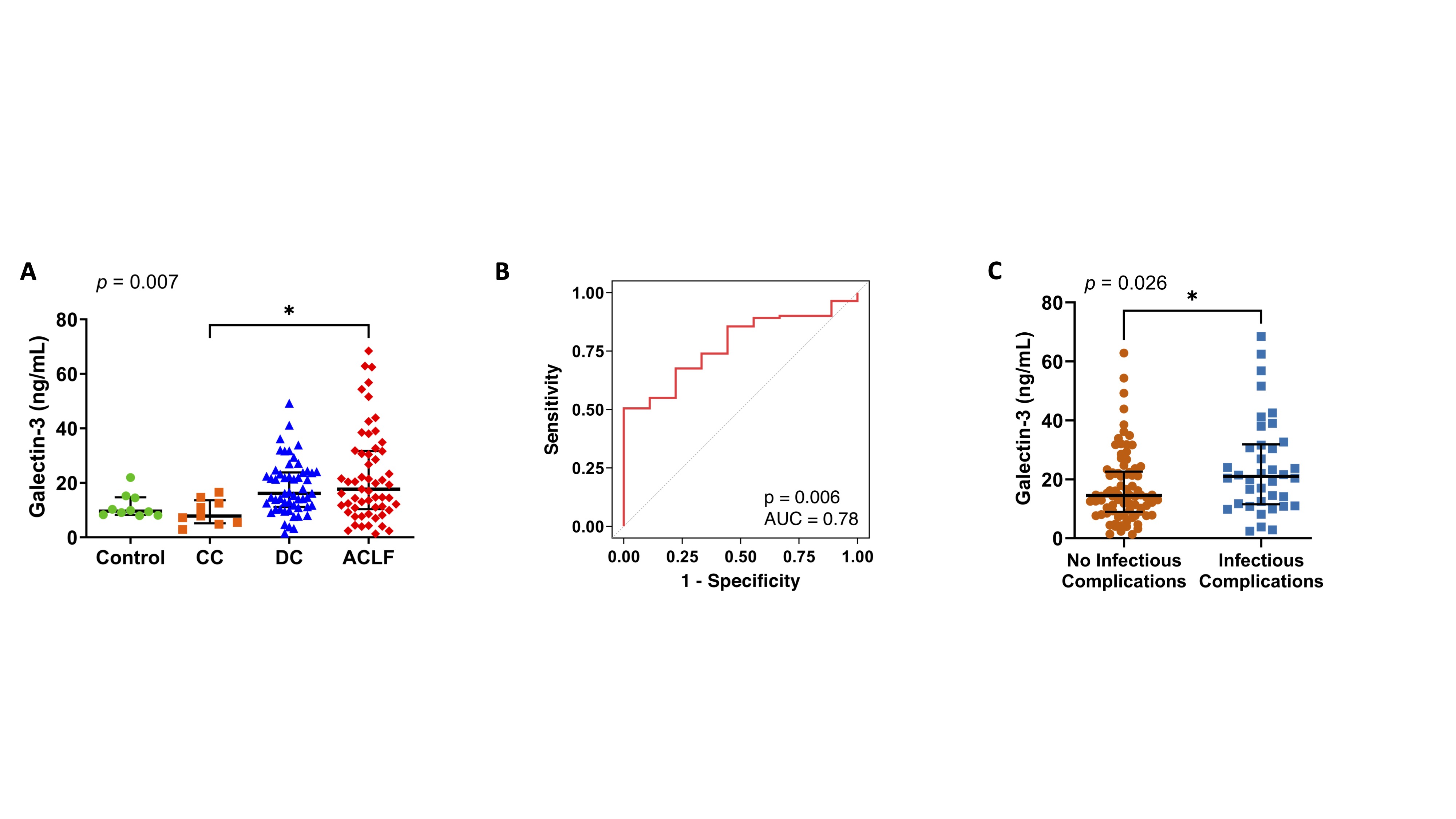Galectin-3 Discriminates Patients with Advanced Cirrhosis and Predicts Post-Liver Transplant Infectious Complications
1Instituto Nacional de Ciencias Medicas y Nutricion Salvador Zubiran, Mexico City, Mexico, 2Liver Unit, Clinica Universidad de Navarra, Hepatology Program, Center for Applied Medical Research, Pamplona, Spain, Pamplona, Spain, 3University of Colorado Anschutz Medical Campus, Denver, CO, 4University of Pittsburgh Medical Center, Pittsburgh, PA, 5Instituto Nacional de Ciencias Medicas y Nutricion Salvador Zubiran, Mexico city, Mexico
Meeting: 2022 American Transplant Congress
Abstract number: 1574
Keywords: Area-under-curve (AUC), Inflammation, Liver cirrhosis, Outcome
Topic: Basic Science » Basic Clinical Science » 17 - Biomarkers: Clinical Outcomes
Session Information
Session Name: Biomarkers: Clinical Outcomes
Session Type: Poster Abstract
Date: Tuesday, June 7, 2022
Session Time: 7:00pm-8:00pm
 Presentation Time: 7:00pm-8:00pm
Presentation Time: 7:00pm-8:00pm
Location: Hynes Halls C & D
*Purpose: An increased demand for liver transplantation (LT) prevails. Galectin-3 is a lectin implicated in inflammation, immunoregulation, and liver fibrosis. In this study we assessed if galectin-3 levels at the time of transplant discriminate patients with advanced cirrhosis and predict post-transplant complications.
*Methods: Sera and liver samples were collected from patients with cirrhosis undergoing LT and from an external cohort of patients with alcoholic liver disease including alcoholic hepatitis (AH). Galectin-3 was analyzed by ELISA, real-time PCR, immunohistochemistry and RNA seq. ROC curves and logistic regression were performed to assess the predictive power of galectin-3 for disease severity and posttransplant infections.
*Results: Increased circulating and hepatic galectin-3 levels were found in advanced cirrhosis vs. compensated cirrhosis and controls (Fig.1A). Galectin-3 significantly correlated with the MELD-Na score and with disease severity parameters and had significant discriminating power for compensated and advanced cirrhosis (Fig.1B). Patients with advanced cirrhosis had important intrahepatic inflammation, with elevation of IL-6, MCP-1, IL-8 and M-CSF, which strongly correlated with galectin-3. Moreover, RNAseq showed higher galectin-3 in severe vs. early AH, correlated with genes reflecting intrahepatic inflammation, and significantly discriminated severe AH. Importantly, circulating galectin-3 was a predictor of early post-transplant infections and was higher in patients with pretransplant systemic inflammatory response syndrome (Fig.1C).
*Conclusions: Galectin-3 is a novel biomarker of active intrahepatic inflammation that discriminates advanced cirrhosis including severe AH and predicts a higher risk of posttransplant infectious complications.
To cite this abstract in AMA style:
Cervantes-Alvarez E, Vilatobá M, Argemi J, Rosa NLimon-dela, Mendez-Guerrero O, Huang C, Kershenobich D, Bataller R, Torre A, Navarro-Alvarez N. Galectin-3 Discriminates Patients with Advanced Cirrhosis and Predicts Post-Liver Transplant Infectious Complications [abstract]. Am J Transplant. 2022; 22 (suppl 3). https://atcmeetingabstracts.com/abstract/galectin-3-discriminates-patients-with-advanced-cirrhosis-and-predicts-post-liver-transplant-infectious-complications/. Accessed December 14, 2025.« Back to 2022 American Transplant Congress

